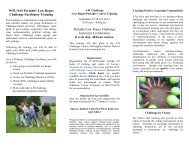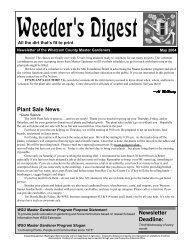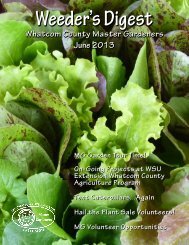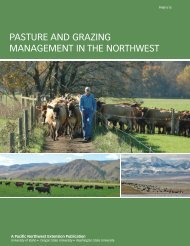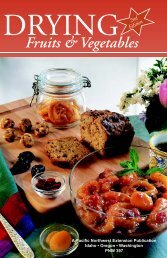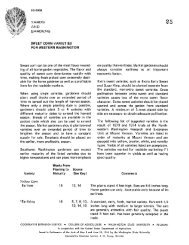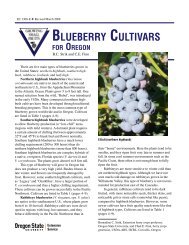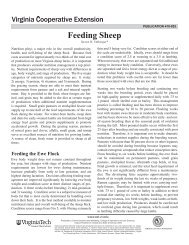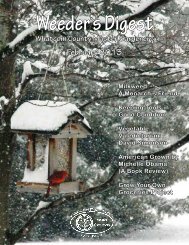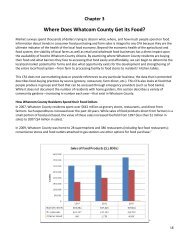August - WSU Whatcom County Extension - Washington State ...
August - WSU Whatcom County Extension - Washington State ...
August - WSU Whatcom County Extension - Washington State ...
You also want an ePaper? Increase the reach of your titles
YUMPU automatically turns print PDFs into web optimized ePapers that Google loves.
All the dirt that’s fit to print<br />
Newsletter of the <strong>Whatcom</strong> <strong>County</strong> Master Gardeners<br />
<strong>August</strong> 2005<br />
Newsletter of the <strong>Whatcom</strong> <strong>County</strong> Master Gardeners<br />
Those of you who are volunteering for the Fair will receive a special mailing containing a letter detailing instructions,<br />
duties, parking and most importantly – your admission ticket. You will also get a copy of our entire Fair schedule, so you will<br />
know who you will be working with, and who will relieve you. If for some reason you must miss your scheduled time to work,<br />
you must pass your ticket on to the person who will take your place. We have to account for each ticket the Fair gives us, and<br />
we cannot get any more. If you have difficulty getting your replacement call Judy Boxx or Al to help you.<br />
Some of you are planning on entering exhibits at the Fair. We have some great tips for entering and winning ribbons with<br />
your vegetables and fruit on our web site, http://whatcom.wsu.edu/ag/agriculture.htm. so check it out and good luck.<br />
Remember, we still need volunteers at Hovander, and the office, during the Fair, so keep on volunteering for those activities<br />
as well.<br />
See you at the Fair!<br />
Al McHenry<br />
The Envelope Please!!!<br />
Wanted: Nominations for<br />
The Broken Shovel Award:<br />
This one’s easy. It’s for any Master Gardener who has put in oodles of volunteer hours and energy toward projects,<br />
committee work, office or clinics.<br />
The John VanMiert Master Gardener of the Year Award:<br />
This is a bit more involved. The recipient’s name will be added to the plaque in the office, and they will be presented with<br />
an individual award to keep at the Master Gardener graduation in November.<br />
The award is given annually to a person who has been a Master Gardener for at least three years. It is to be awarded for<br />
exemplary service to the Master Gardeners of <strong>Whatcom</strong> <strong>County</strong> and the community. John has had so much influence on us all as<br />
a teacher, a writer, a speaker, a diligent worker, and a volunteer extraordinaire. Therefore, the service of the recipient of this award<br />
might be in the form of one or more of the following:<br />
a. TAUGHT a class, a workshop, a clinic, a course, seniors at a retirement home, or kids on an outing.<br />
b. WRITTEN a book, a poem, an article, a newsletter column.<br />
c. SPOKEN to a group of children, a garden club, a class of Master Gardeners, the public.<br />
d. Spent far too many hours to count each year WORKING in support of a specific project, such as the Hovander demonstration<br />
garden, the annual plant sale, the greenhouse, cleaning and organizing the office.<br />
e. Given an extraordinary number of hours of VOLUNTEER TIME, such as keeping regular hours at the office no matter what,<br />
helping set up and run the Master Gardener classes, or putting in countless hours towards organizing the advanced<br />
training program.<br />
Please send in your nominations soon to Chris Hurst at cchurst@gte.net or 366-5501.<br />
<strong>WSU</strong> Master Gardener Program Purpose <strong>State</strong>ment:<br />
To provide public education in gardening and home horticulture based on research-based<br />
information from <strong>WSU</strong> <strong>Extension</strong>.<br />
<strong>WSU</strong> Master Gardener Program Slogan:<br />
”Cultivating Plants, People and Communities since 1973"<br />
Newsletter<br />
Deadline:<br />
Third Wednesday of every<br />
month.<br />
Cooperating agencies: <strong>Washington</strong> <strong>State</strong> University and U.S. Department of Agriculture. <strong>WSU</strong> <strong>Extension</strong> programs and employment are available to all without discrimination.<br />
Evidence of noncompliance may be reported through your local <strong>WSU</strong> <strong>Extension</strong> Office.
Weeder’s Digest<br />
Tis the Season<br />
By Faye Agner<br />
It seems as though summer is here.<br />
It got off to rather a stuttering start with<br />
unexpected rain in July. Now we can get<br />
on with our summer plans. If you are<br />
going to be gone, be sure and not leave<br />
signs of your being away by having<br />
newspapers, etc. pile up. Your neighbors<br />
will not thank you for this. Maybe you<br />
can bribe one of your friends/neighbors<br />
to take care of watering and such while<br />
you are gone. Tell them they can harvest<br />
from your garden as a reward.<br />
Now is the time to start planning<br />
for your winter and fall garden. Plant<br />
beets, cole crops (broccoli, cabbage,<br />
collards, kale, kohlrabi), leeks, lettuce,<br />
onions, peas, radishes, and spinach.<br />
<strong>August</strong> is the best time to prune<br />
fruit trees as it can help prevent rampant<br />
sprout growth next spring. Pruning at<br />
this time removes many of the leaves that<br />
transfer energy in fall to be used by the<br />
tree for growth in the spring. As long as<br />
you don’t remove more than a third of the<br />
foliage, the energy loss will not harm the<br />
tree. Prune to give the tree a vase shape<br />
rather than that of an umbrella. There is a<br />
hormone that makes growth happen at<br />
the highest point in the tree. If the center<br />
is the highest point, you get the Medusa<br />
effect with hundreds of sprouts growing<br />
right out of the middle. If the outer<br />
branches aim upward, the hormone<br />
causes growth where it is needed, at the<br />
tips of the branches, and sprout growth<br />
will be much less.<br />
As a general rule, fruit trees don’t<br />
need to be fertilized, instead, they need to<br />
be watered regularly in order to produce<br />
juicy, delicious fruit. As with most trees,<br />
the best way to water is with a soaker<br />
hose. The sun tends to degrade soaker<br />
hoses, so don’t forget to cover them with<br />
at least an inch of mulch. As an added<br />
benefit, the mulch will slow evaporation,<br />
cool the soil temperatures and make the<br />
water spread more evenly over the root<br />
zone.<br />
A trick to growing huge lilies next<br />
year is to feed them now, right after they<br />
quit blooming. Food manufactured in the<br />
leaves is sent down to be stored as<br />
energy in the bulb. The more energy<br />
stored, the bigger the bulb and the more<br />
spectacular your lily display will be next<br />
summer. Give your lilies a shot of organic<br />
bulb food now, and you will be rewarded<br />
with huge flowering stalks next summer.<br />
Powdery mildew is a common<br />
problem this time of year. Odd as it<br />
seems, the easiest way to prevent this<br />
fungus is to water adequately. Underwatered<br />
plants are highly susceptible.<br />
Powdery mildew is the only fungus that<br />
lives on the outside of the leaves. Unlike<br />
other fungus diseases, it can be easily<br />
controlled if a spray is applied at the first<br />
sign of the disease (it is too late once the<br />
leaves are covered).<br />
Bald-faced hornets are beneficial.<br />
These are the bees that make paper wasp<br />
nest in trees and shrubs like rhododendrons.<br />
They are large black (white spots<br />
on the head and rump) yellow jackets and<br />
eat lots of plant eating bugs. For fun,<br />
watch them hover just above the lawn<br />
looking for crane flies. The crane fly<br />
hides in the grass waiting for a chance to<br />
lay her eggs. If she is spotted by a baldfaced<br />
hornet as she is taking off, the<br />
hornet will swoop down and bite the<br />
crane fly’s head off in mid air. Next to be<br />
bitten off are the wings and the legs. The<br />
remainder of the crane fly is then taken<br />
back to the nest. Put up warning signs<br />
and barricades to make sure the kids and<br />
the dog don’t go near the nest.<br />
Tend your roses now. For a second<br />
flush of bloom in fall, give roses plenty of<br />
water during the warm <strong>August</strong> days and<br />
feed them with a complete fertilizer. Also,<br />
apply iron chelate if leaves look chloroic<br />
(yellow with green veins). Make certain<br />
the soil is moist before applying and<br />
water thoroughly afterward. Snip off old<br />
blooms and rose hips; lightly shape<br />
plants if necessary.<br />
Uneven watering causes cracked<br />
tomatoes. Cracked tomatoes are not only<br />
unappetizing; they are also quick to spoil.<br />
To avoid this problem, keep your<br />
tomatoes watered. If they are allowed to<br />
dry out and then are watered the plant<br />
takes up too much too quickly and the<br />
excess is stored in the fruit. The fruit<br />
cracks because as the skin turns red, it<br />
also looses flexibility and can’t expand to<br />
accommodate the excess fluid. To solve<br />
the problem, irrigate regularly and apply<br />
mulch to keep the soil evenly moist.<br />
Your plants will last better and take<br />
less watering by mulching around the<br />
roots to keep them cool. Mulch also<br />
helps water soak into the soil rather than<br />
run off and it slows evaporation. Mulching<br />
can take the form of organic material<br />
such as shredded leaves, which helps<br />
improve the soil as it conserves moisture.<br />
Let the size of your plant be your guide<br />
as to how deep to spread it. The larger<br />
the plant, the more mulch it can handle.<br />
You do not want to bury your low<br />
growing plants. If you do not have leaf<br />
mulch, shredded wood or bark works fine.<br />
It will not break down as fast to improve<br />
the soil. Be careful about using stone or<br />
gravel mulch. It can actually get very hot<br />
and cause moisture to evaporate rather<br />
than conserving it.<br />
If you don’t already have a<br />
compost pile, here is an easy way to start<br />
one. To hold the compost, join four 4-by<br />
4-foot square wood pallets, the kind used<br />
in home and garden stores, often<br />
available free if they are damaged, at the<br />
corners to make a bottomless, opentopped<br />
box. Toss in a blend of vegetable<br />
scraps (everything from apple cores to<br />
carrot tops) and garden waste such as<br />
grass clippings and seedless weeds.<br />
Water the pile to keep it as moist as a<br />
wrung-out sponge and turn it weekly<br />
with a garden fork. You’ll have rich<br />
compost in a couple of months. As you<br />
tear out spent summer flowers and<br />
vegetables, combine them with the grass<br />
clippings and non-meat kitchen waste to<br />
make compost for your fall garden.<br />
Who am I?<br />
I am from a genus of about 9<br />
species of bold, stiff perennials from dry<br />
prairies, gravelly hillsides, and open<br />
woodland in Central and Eastern North<br />
America. I usually have thick black<br />
rootstocks and short rhizomes. Erect,<br />
hairy stems bear linear-lance-shaped to<br />
ovate, entire, toothed or deeply pinnatifid,<br />
bristly, dark green leaves. Solitary,<br />
daisy-like, purple, red, pink or white<br />
flower-heads with pointed stiff scales on<br />
the undersides, and prominate, ovid or<br />
cone-shaped brownish yellow to orange<br />
central discs are produced on terminally,<br />
thick branched stems.
President’s Message<br />
Linda Bergquist,<br />
MGF President<br />
GREAT EXPECTATIONS<br />
Our <strong>Whatcom</strong> Master Gardener Foundation has a stated<br />
mission to help educate our community, and we have many<br />
activities aimed to do just that. In talking with members of other Master Gardener<br />
Foundations, and reading their newsletters, I find that we offer programs, trips, and<br />
events that they have never made available to their members. Our members often ask<br />
me, “When is our next trip?”, or “Who is speaking at the next Foundation meeting?”<br />
Most Foundations don’t even have monthly meetings!<br />
Thanks to Chris Hurst and Karen Gilliam we had a very informative trip in June.<br />
They did all the researching, calling, and organizing. We have come to expect these<br />
wonderful trips every year!<br />
Our Foundation meetings always have knowledgeable speakers and we have<br />
come to expect that too! Loretta Hogg and Gretchen White, as part of their VP duties,<br />
are responsible for a lot of research, organization, and scheduling to get these speakers.<br />
When we attend these meetings we have come to expect coffee, tea and wonderful<br />
goodies. Without Barbara DeFreytas and JoAnne Roose this would not be<br />
available.<br />
Our Advanced Training in the fall, one way each of us can fulfill our continuing<br />
education requirement, is attended by Master Gardeners from all over <strong>Washington</strong> and<br />
even some from Canada. Everyone expects the training to be fantastic! Loretta Hogg,<br />
Kaye Dykas, Chris Hurst, Ann Rogalla, Arlene Dangelmaier, Bill Baldwin, and Sandy<br />
Keathley have been working for a year on this event. I have seen the fruits of their<br />
labor and I know it will meet or exceed our expectations.<br />
Last year our NW <strong>Washington</strong> Fair Booth did us proud! From the looks of the<br />
plans for this year, Judy Boxx and Donna Berry will be working their magic again and<br />
we will have a very professional representation. We have come to expect this, too!<br />
Much of the community knows of our work at Hovander Park. Everyone expects<br />
it to be educational and beautifully presented. If David Simonson did not read many,<br />
many seed catalogs and start ALL the vegetables in his greenhouse there wouldn’t be<br />
a Demonstration Garden. If Dick Porter didn’t do the same for the Dahlia Garden it<br />
wouldn’t exist! Kendra Bradford and Christina Tawes have made the Native Plant<br />
Garden come alive! Barbara Schmit works on the perennials around the house and<br />
Elisabeth Bays is in charge of the Herb Gardens. Because of them our expectations are<br />
met.<br />
Pat Nelson, our volunteer coordinator, makes sure our community outreach<br />
mission is met. She gets requests from many different organizations in our area. They<br />
expect our usual hard work and dedication and we always deliver.<br />
Leslie Clark, one of our new members, sent in a request for help at Lydia Place.<br />
Christine Morris needs help at the Bellingham Farmer Market on Saturdays. These are<br />
great, new opportunities to show off our great organization, share our knowledge, and<br />
fulfill our education mission.<br />
SO, when YOU are called on to help, remember - we have great expectations for<br />
YOU, too! “I can’t help, I have already done my hours” just isn’t our style.<br />
Timesheets<br />
It’s July and many of you are working hard to fufill your volunteer hour commitment.<br />
Don’t forget to record those hours and submit them to the <strong>Extension</strong> Office on a<br />
regular basis.<br />
You can pick up a paper copy of the timesheet to fill out and mail in at the office.<br />
Or, why not submit your hours online: http://whatcom.wsu.edu/mastergardener/. Click<br />
on “For MG’s Only.” If you need the username and password to get into this secure<br />
area contact Karri Neuhauser at the <strong>Extension</strong> Office, 360/676-6736 or<br />
karrimac@wsu.edu.<br />
<strong>August</strong> 2005<br />
Annual Hovander<br />
Picnic!<br />
On<br />
Thursday,<br />
<strong>August</strong> 11, at<br />
6:30 p.m. we will<br />
have a pot luck<br />
dinner at the<br />
beautiful<br />
Hovander Park facility in Ferndale. For<br />
those of you who have never been, it is a<br />
real treat! Please bring your family! After<br />
dinner you can show them, the new<br />
Economic Garden, the progress at the<br />
Demonstration Garden, the Native Plants<br />
Garden and the Historical house and<br />
surrounding gardens. They are all a short<br />
stroll from the picnic area. You will see<br />
the Group Picnic sign just as you are<br />
about to turn toward the parking area.<br />
You drive straight ahead and follow the<br />
gravel road until you come to a covered<br />
picnic area, with a cement floor, fireplace,<br />
and picnic tables. They hold weddings<br />
and special events in this facility. BRING<br />
YOUR FAMILY’S FAVORITE DISH!<br />
Bring an entrée, salad or dessert. You<br />
may bring your own place settings or we<br />
will provide them. We will have water,<br />
juice, coffee and tea. It has always been<br />
lots of fun!<br />
Advanced Training<br />
Seminar,<br />
Friday, September 30 -<br />
Hampton Inn<br />
EARN 5<br />
HOURS OF<br />
ADVANCED<br />
TRAINING<br />
CREDIT IN ONE<br />
DAY!<br />
Look for<br />
your seminar<br />
brochure enclosed in this issue of the<br />
Weeders Digest. Please return your<br />
registration ASAP. You will enjoy hearing<br />
from the four speakers: Sharon Collman,<br />
Sam Benowitz, Mary Robson and Russell<br />
Link; reviewing numerous display<br />
materials and books by the authors, and<br />
sharing gardening news with fellow<br />
Master Gardeners over lunch.
Weeder’s Digest<br />
Plant of the Month............................ By Cheryll Greenwood Kinsley<br />
Kale<br />
Family: Cruciferae<br />
(Mustard family)<br />
Genus: Brassica<br />
Species: oleracea<br />
Texas A&M University Department of<br />
Horticultural Sciences and Aggie Horticulture<br />
This month’s article is as much a reminder for me as anything else, to start some kale from seed in<br />
flats about now. I love the look of our gardens this time of year—exuberant, more than slightly overgrown,<br />
and very colorful. In the vegetable plot as well as the flowerbeds, everything tumbles together:<br />
blossoms, fruit, and seedheads, twining vines and leafed-out branches. As the summer progresses,<br />
however, it will be time to start taking things out, whether nasturtiums or petunias, and there will be<br />
holes here and there. While I won’t be able to recapture summer’s exuberance as<br />
we move into fall, I can be prepared with some fresh stock to cover patches of bare<br />
earth.<br />
For years I dismissed ornamental kale as too garish. There was something<br />
almost artificial about that combination of pink, purple, and teal that didn’t sit right<br />
with me. But tastes change. New varieties become available. And a couple of years<br />
ago I found myself coveting some “flowering” kale with either pure red or clear<br />
white centers clustered within outer leaves of true, deep green. The only trouble?<br />
They were pretty pricey, particularly if I wanted a number of them to line a walkway<br />
or fill several containers.<br />
But for half the price of a single plant at the nursery, I can buy one packet of<br />
seeds. The trick is to start them at the right time, in the right way, so I’ll have as<br />
many pretty heads of ornamental kale as I need.<br />
Now is the time—don’t wait past early <strong>August</strong>—and flats are the way to go.<br />
I sow leafy kale—the kind I plan to eat—directly into the ground, in the place set<br />
aside for vegetables. Unlike chard, it doesn’t suit me to mix it in with my ornamentals.<br />
I like to harvest the thinnings and then keep taking the outer leaves while<br />
they’re small to use in September salads. As the weather cools, the plants grow bigger and their leaves<br />
become both tougher and sweeter, making them perfect for pot greens by November. So the kale I plant<br />
to eat really needs a place of its own.<br />
But the kale I plan to admire is treated a little differently. By sowing seeds in flats now, I’ll have starts to transplant into small<br />
pots in a month. And by the first of October, if I tend them properly, I’ll have a number of pretty little heads of ornamental kale to<br />
put along the walkway or in containers by the front door. I might choose ‘Sunset’ or ‘Sunrise’—can you guess how these differ in<br />
color?—or the particularly attractive Nagoya mix for pure white and pure red. The plant breeders have been busy with kale during<br />
the last two decades, taking the most ancient of the Cruciferae to new aesthetic heights for our modern sensibilities. What we call<br />
kale is the forerunner of broccoli, Brussels sprouts, and most cabbages. The Greeks ate it, the Romans followed suit and took it on<br />
the road with them all over Europe.<br />
The trick to growing kale is to make sure it has cool weather as it matures. But it also needs warmth to germinate. So for our<br />
region, it’s the perfect fall crop—particularly the ornamental varieties. Starting seeds in flats, outdoors, now avoids many of the<br />
problems associated with starting seeds indoors in late winter and early spring. Better air circulation, and fresh air in general, means<br />
less chance of damping-off. The starts are likely to be sturdy and healthy. By transplanting them into small pots and keeping them<br />
well-watered and lightly fed, you’ll be able to choose the best-looking heads as ornamental features. And if you use a seed mix,<br />
you’ll have a clear fix on the colors you’re dealing with so you can place them where the combinations will please you. One other<br />
advantage: not all of them will look like the ones in the catalog. Some will be irregularly shaped, some will look lumpy. You’ll be able<br />
to select the best of the lot. Plant them in the ground up to their first set of leaves, and you’ll keep them from growing lanky and<br />
flopping over. The cool fall weather will bring out their color, once they’re safely tucked in the ground.<br />
And yes, you can eat any ornamental kale that doesn’t make the cut. It’s not as tasty or tender as the culinary varieties—it’s<br />
bred for looks, remember—but it’s still nutritious and pleasant to eat when you toss a handful of leaves cut into strips into soup, for<br />
example, during the last few minutes of cooking time.<br />
So, if you start some ornamental kale right away, no later than mid-<strong>August</strong>, you’ll have the opportunity this year to have your<br />
kale and eat it, too.<br />
Hovander Update<br />
Projects at the demonstration garden are looking well tended as late summer nears. We’ve had lots of volunteers lately to<br />
zero in on the weeds in the pumpkins and corn maze.<br />
We’ve experienced the usual problems such as lots of cabbage worms and slugs. And, the long-standing ritual of sampling<br />
fava beans will not happen this year as our plants couldn’t survive a peacock attack!<br />
We’re hoping to have a big turnout at the <strong>August</strong> MG picnic here at Hovander Park. While here—be sure to check out the<br />
various projects that volunteers have worked so hard on this year.
<strong>August</strong> 2005<br />
Youth and Gardening<br />
~Craig MacConnell<br />
The latest issue of HortTechnology (July – September<br />
2005, V. 15, n 3) contains a special section on Youth in Horticulture<br />
with eleven scientific papers presented on the topic. Three<br />
of the papers give results from the utilization of the Junior<br />
Master Gardener program originally developed by Texas A& M<br />
University and now a national 4-H program that is replicated in<br />
twenty eight Land Grant universities.<br />
The Junior Master Gardener program engages children in<br />
novel, “hands-on” group and individual learning experiences<br />
that promote a love of gardening, develop an appreciation for<br />
the environment, and cultivate the mind. JMG encourages youths to be of service to others through<br />
service learning and leadership development projects and rewards them with certification.<br />
The Junior Master Gardener curricula are divided into two age/grade ranges. JMG Level One is<br />
developed for grades 3 - 5, where children taking part can get involved in exploring their world<br />
through meaningful activities that strengthen academic achievement, encourage leadership development,<br />
personal pride and responsibility, and community involvement. Youths involved in the program develop critical thinking<br />
skills, and the ability to identify community concerns and take action to address them through individual group projects. JMG<br />
Level Two is designed for grades 6 – 8 and includes the “Operation Thistle – Seeds of Despair” module where middle school and<br />
junior-high youths investigate Plant Growth & Development while engaging them in an urgent mission to defeat the evil Dr. Thistle.<br />
Students will work as a group to complete lessons in each of the 8 learning concepts, then work independently to complete activities<br />
found within the mission briefs & mission option pages. By completing these missions, students help foil the twisted plans of<br />
Thistle and his menacing gang while reinforcing concepts learned in the group setting. Shades of Harry Potter.<br />
In addition to the grade based curricula, the Junior Master Gardener program has also developed stand alone, theme based<br />
curricula, called the Golden Ray Series, such as Health and Nutrition from the Garden and Wildlife Gardener in conjunction with the<br />
National Wildlife Federation.<br />
Leanna Smith and Carl Motsenbocker, with Louisiana <strong>State</strong> University report in their study of three East Baton Rouge Parish<br />
elementary schools using the first four chapters of JMG Level One Handbook that changes in pre and post science achievement<br />
scores were statistically better for the group that participated in the JMG curricula as compared to a control group. The authors<br />
state “…the results show once weekly use of gardening activities and hands-on classroom activities help improve science achievement<br />
test scores.”<br />
Amy Dirks and Kathryn Orvis, with Purdue University, Indiana, report in their study of eleven schools in ten counties in<br />
Indiana that student pre and post tests indicated overall significant gains in science, horticulture, and environmental knowledge<br />
and attitudes as a result of receiving training using the Junior Master Gardener curriculum. According to Dirks and Orvis, teachers<br />
indicated that they were satisfied with the program in their classrooms and planned to continue with the JMG for future classes.<br />
Poston, Shoemaker, and Dzewaltowski, all with Kansas <strong>State</strong> University, report student changes as a result of two after school<br />
programs with the Boys and Girls Club, Professor Popcorn, a nutrition education program developed<br />
by Purdue, and the Junior Master Gardener program. The authors found that neither program improved<br />
nutrition knowledge nor fruit and vegetable preferences or consumption. The authors did<br />
indicate that there was potential for bias in selection of the student participants.<br />
A team of members of the 2005 <strong>Whatcom</strong> <strong>County</strong> Master Gardener class did pilot the Junior<br />
Master Gardener program material this year. Soon we will have our own qualitative data on JMG<br />
program and its impact on <strong>Whatcom</strong> <strong>County</strong> youth.<br />
For more information on the Junior Master Gardener program see http://www.jmgkids.us/ or<br />
Google for a large number of state JMG websites.<br />
Office:<br />
Master Gardener<br />
1000 N. Forest St., Suite 201<br />
Bellingham, WA 98225<br />
360/676-6736<br />
Weeder’s Digest is the monthly newsletter for the <strong>Whatcom</strong> <strong>County</strong> Master Gardener Program. Guest articles are encouraged. Please submit<br />
typewritten articles by the third Wednesday of each month to Karri at the Master Gardener Office. Articles can also be submitted by e-mail to:<br />
karrimac@coopext.cahe.wsu.edu. Editor uses MS Word for Windows and PageMaker 6.5. Any articles prepared on other programs or platforms<br />
should be saved as Text Files or Rich Text Files. Editor reserves the right to edit for space considerations, grammar, spelling and syntax.<br />
Craig MacConnell<br />
Horticulture Agent
<strong>WSU</strong> WHATCOM COUNTY EXTENSION<br />
1000 N. FOREST STREET, SUITE 201<br />
BELLINGHAM WA 98225-5594<br />
PRSRT STD<br />
US POSTAGE<br />
PAID<br />
BELLINGHAM WA<br />
PERMIT NO. 85<br />
Dates to Remember:<br />
<strong>August</strong> 4........................... 10 a.m. to noon ....................Monthly Foundation Board Meeting<br />
<strong>Extension</strong> Office<br />
<strong>August</strong> 11 ......................... 6:30 p.m. ..............................Monthly Foundation Meeting<br />
Annual Potluck at Hovander<br />
<strong>August</strong> 15 -20 .................. All Day .................................Northwest <strong>Washington</strong> Fair<br />
Lynden<br />
September 7 -9 ................ All Day .................................WA <strong>State</strong> Annual MG Conference<br />
Pullman, WA<br />
September 30 .................. All Day .................................<strong>Whatcom</strong> <strong>County</strong> MG Advanced Training<br />
Fox Hall, Hampton Inn<br />
Wednesdays .................... 8 to 9 a.m. ............................Master Gardener breakfasts<br />
Babe’s in Ferndale<br />
Wed. & Sat. ..................... 9 a.m. to noon ......................Hovander Work Parties<br />
Wednesday...................... 1 to 4 p.m. ............................Bellingham Library Clinic<br />
Saturdays......................... 9 a.m. - 2 p.m. ......................Bellingham Farmers Market Booth



